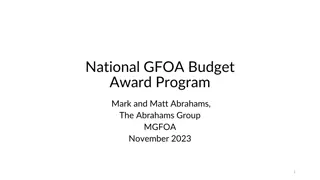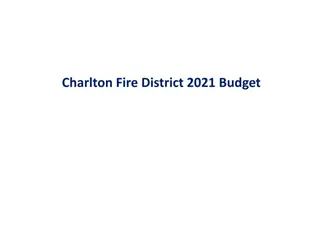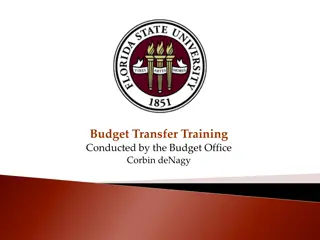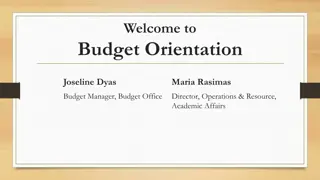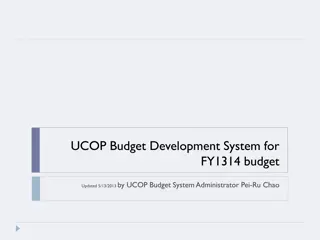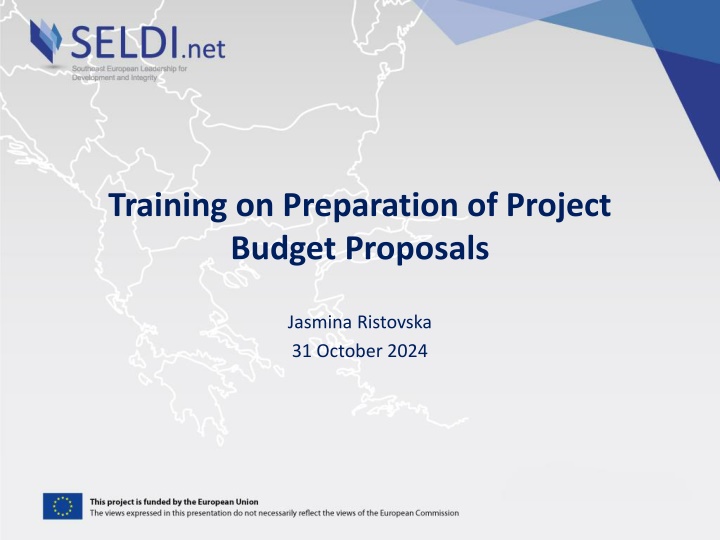
Project Budget Proposal Preparation Training: EU Rules & Guidelines
Gain a comprehensive understanding of preparing project budget proposals in compliance with EU rules, focusing on the specific SELDI Small Grants Programme. Explore general principles, grant contract rules, budget structure, and validation processes to enhance confidence in budget preparation.
Download Presentation

Please find below an Image/Link to download the presentation.
The content on the website is provided AS IS for your information and personal use only. It may not be sold, licensed, or shared on other websites without obtaining consent from the author. If you encounter any issues during the download, it is possible that the publisher has removed the file from their server.
You are allowed to download the files provided on this website for personal or commercial use, subject to the condition that they are used lawfully. All files are the property of their respective owners.
The content on the website is provided AS IS for your information and personal use only. It may not be sold, licensed, or shared on other websites without obtaining consent from the author.
E N D
Presentation Transcript
Training on Preparation of Project Budget Proposals Jasmina Ristovska 31 October 2024
Training Objectives Aim: Obtain general understanding of the main principles for preparation of project budget proposals in line with EU rules, with particular attention to the rules governing the specific SELDI Small Grants Programme Call Result: Being confident in preparing sound project budget proposals
Agenda General principles for grant contracts Rules defined with the Guidelines for Applicants for the SELDI SGP Call Structure of the budget and its main components
General principle for grant contracts Grants must adhere to the principles of co-financing, the prohibition of double financing, and non-profit endeavors: Co-financing Principle Non-Cumulative Award/ No Double Financing Non-Profit Principle
Budget validation process before contract signature CA ensures that proposed budget proposals comply with the Guidelines for Applicants, including: Grants requested falling within specified minimum and maximum amounts and percentages of total eligible costs Expenditures proposed by potential applicants meet eligibility criteria Correct any evident mathematical errors, ensure that expenses align with activities and market rates, and remove any ineligible costs Modifications cannot increase the requested grant amount or the CA s contribution percentage; It may result in a reduction of the total CA contribution
General rules (1) General Rules: Guidelines for Applicants provides clear guideline on eligibility of costs The budget must be detailed and balanced Presented in euro/ currency specified in the given Call All information in the Budget, Justification, and Expected Sources of Funding Applicants are required to: Abide by the principles of economy and efficiency Ensure it is accurate, realistic, and cost-efficient Validate the reasonableness of costs in line with market prices and proposed project activities Reimbursement of eligible costs based on the actual costs incurred by the beneficiary(ies)
General rules (2) Estimated costs exclusively for the implementation of the action Two types of costs: direct eligible costs and indirect costs Direct costs: Categorized under six main budget headings Directly associated with implementation of proposed activities and can be directly allocated to it Specific to the project and arise solely from its implementation Identifiable, verifiable, and necessitate supporting documentation as proof Various budget items where individual direct costs are defined - descriptions must be sufficiently detailed, with all components broken down The quantity of units and unit value specified for each item Include costs related to the project as a whole, irrespective of the part financed by CA Applicants should avoid any unnecessary or unnecessarily high expenditure Consulting market prices is recommended
General rules (3) The grant covers only eligible costs - the actual expenses incurred by the beneficiary(ies) meeting the following criteria: Occur during the project's implementation period as specified in the Grant Contract Outlined in the project budget Essential for implementing the project activities Identifiable and verifiable, recorded in the beneficiary(ies)' accounting records, and determined according to applicable accounting standards and cost accounting practices Observe the requirements of relevant tax and social legislation Reasonable, justified, and in line with the principles of sound financial management, particularly regarding economy and efficiency The budget estimate must be properly balanced: income and expenditure must be equal (no-profit rule) Co-financing of the eligible costs of the action may come from sources other than EU budget Contributions in kind (i.e. non financial resources made available free of charge by the beneficiaries or by third parties to the beneficiaries) cannot be accepted as co-financing
SELDI Small Grants Call rules (1) Contracting Authority Contribution in percentage min 70% - max 90% of total eligible costs absolute amount min EUR 7,000 - max EUR 10,000 Duration min. 9 months - max. 12 months Only eligible costs can be covered by the grant The budget should be realistic and cost-effective
SELDI Small Grants Call rules (2) Eligible direct costs gross salary costs for the staff involved in the implementation of the project; costs of travel related to the activities in the project, including local and international travel costs direct costs incurred during the implementation phase of the proposed activities (including costs for research and publications, organisation of conferences/ seminars, costs for external persons/experts who will be requested to provide professional support, etc.) project office costs that are relevant to the proposed activities The indirect costs incurred in carrying out the project may be eligible for flat rate funding, but the total must not exceed 7 % of the estimated total eligible direct costs Contingency reserve - N/A
SELDI Small Grants Call rules (3) Contributions in kind N/A Financial Support to Third Parties re-granting is NOT ALOWED Ineligible costs debts and debt service charges (interest) provisions for losses or potential future liabilities costs declared by the beneficiary(ies) and financed by another action or donor purchases of land or buildings reconstruction and renovation of buildings purchasing vehicles, furniture and IT equipment currency exchange losses credit to third parties salary costs of the personnel of national administrations
Budget Structure (1) Costs 1. Human Resources 2. Travel 3. Equipment and Supplies 4. Local Office 5. Other costs, services 6. Other 7. Subtotal direct eligible costs of the Action (1-6) 8. Indirect costs (maximum 7% of 7, subtotal of direct eligible costs of the Action) 9. Total eligible costs of the Action, excluding reserve (7+ 8) 10. Provision for contingency reserve (maximum 5% of 7, subtotal of direct eligible costs of the Action) 11. Total eligible costs (9+10)
Budget Structure (2) Budget headings should not be changed Budget lines under each heading should be adjusted in accordance with the project proposal The description of items must be sufficiently detailed and all items broken down into their main components The number of units and the unit value must be specified for each item depending on the indications provided The budget has to include costs related to the Project as a whole, regardless the part financed by the Contracting Authority The budget should be established in EUR currency (for this Call) Provide explanation for each budget item in the justification section Recommendation: Use formulas in the Excel to avoid mathematical errors
Budget Heading 1 Human Resources Salaries Cost of staff - gross salaries or wages, inclusive of applicable income taxes, social security contributions, and other remuneration-related expenses - eligible if the staff members are essential to the implementation of the project activities Cost of staff working under an employment contract/ equivalent appointing act and assigned to the action Salary costs must be actual and should not exceed the rates corresponding to the beneficiary's usual policy on remuneration Backed by appropriate documentation (contracts, payslips, etc.) Actual time spent on the action - recorded on regular basis using timesheets or an equivalent time registration system established Presented with categories of staff according to their role in the project (Coordinator, Project manager, etc.) Allocation of staff members - reasonable in comparison to the workload imposed with the implementation of the Project
Budget Heading 1 Human Resources Salaries Supporting documents proving historical rates might be requested by the Contracting Authority prior contract award If project team members are not working full-time on the project, the percentage of their engagement should be indicated alongside the item description The percentage of involvement should be reflected under the number of units, not under unit value Present full gross salaries under unit value, including all contributions, according to applicable laws Budgeted salaries should present those normally borne by the Applicants
Project budget and justification of the budget, Example, BH 1 - Salaries Clarification of the budget items Justification of the estimated costs Unit value (in EUR) Total Cost (in EUR) Provide a narrative clarification of each budget item demonstrating the necessity of the costs and how they relate to the project (e.g. through references to the activities and/or results in the Project Description). Costs Unit # of units Provide a justification of the calculation of the estimated costs. 1. Human Resources 1.1 Salaries (gross salaries including social security charges and other related costs, local staff) 1.1.1 Technical Per month All activities A.1-A.6. Project Coordinator with 40% of her/his working time will be assigned to the project. Project Coordinator will be responsible for the overall management of the project implementation. The Project Coordinator will be the main point of contact with the donor, and will also assure the highest quality of expertise and professionalism in all tasks and obligations. The salary that is budgeted for this position is in line with the project responsibilities and is corresponding to actual gross salaries including social security charges and other remuneration that are normally borne by the applicant for this position. Project manager 40% Per month 4.8 800 3,840.00 1.1.2 Administrative/ support staff Per month All activities A.1-A.6 Financial Officer at the applicant (average 10% of her/his working time for the project duration), responsible for ensuring the correct financial implementation and delivery of reports. The salary that is budgeted for this position is in line with the project responsibilities and is corresponding to actual gross salaries including social security charges and other remuneration that are normally borne by the Organisation for this position. The salary that is budgeted for this position is in line with the project responsibilities and is corresponding to actual gross salaries including social security charges and other remuneration that are normally borne by the Organisation for this position. Finance Officer 10% Per month 1.2 700 840.00 All activities A.1-A.6. Administrative Officer at the applicant (average 10% of her/his working time for the project duration), ensuring adequate administrative support to Project Team Administrative Officer 10% Per month 1.2 700 840.00
Points of check for budget conformity with general rules applicable to BH 1 HR, Salaries Evaluate whether the allocation of staff members is reasonable given the project's workload Ascertain whether staff members will be engaged on a full-time or part-time basis for the project If not full-time, ensure that their level of involvement is clearly stated alongside the item description. The percentage of their engagement should be specified under the number of units, not under unit value Ensure that you included the entire gross salary under unit value, including all contributions mandated by applicable laws Gross salaries should be those normally borne by the applicants, based on standard HR practices within the organization
Budget Heading 1 Human Resources Per Diems Subsistence expenses for project staff and participants on events/conferences - eligible if essential for project activities Should not surpass what is normally borne by applicants, as per its usual practices in force or internal policies and regulations Per Diems/ Daily subsistence allowance cover accommodation, meals, local transportation etc. Applicants should indicate places/ cities of travel (if possible) in compliance with the activities foreseen under the Project Provide clear information to the activity it relates, and how costs have been budgeted
Project budget and justification of the budget, Example, BH 1 - Per-diems Clarification of the budget items Justification of the estimated costs Unit value (in EUR) Total Cost (in EUR) Provide a narrative clarification of each budget item demonstrating the necessity of the costs and how they relate to the project (e.g. through references to the activities and/or results in the Project Description). Costs Unit # of units Provide a justification of the calculation of the estimated costs. 1. Human Resources 1.2 Per diems for missions/travel 1.2.1 Abroad (staff assigned to the Project) Per diem Per-diems for participation to a Policy Forum in Tirana (2 project team members, 2 nights) Activity A.3.3 This budget line will cover costs for per-diems for 2 representatives from the applicant organisation on the regional event in Tirana The unit value is determined as average per- diem rate for WB countries according to official EC per-diem rates, lowered for cost of light lunch provided on events. Per diem 4 110 440.00 1.2.2 Local (staff assigned to the Project) Per diem 1.2.3 Seminar/conference participants Per diem The unit value is determined on the basis of inflation adjusted historical rates and actual market prices as provided in unbinding market offers. Activity A.1.2 This Budget line will cover costs for half-board accommodation of 20 participants. 2-Days workshop in Ohrid (20 participants) Per diem 40 60 2,400.00
Points of check for budget conformity with general rules applicable to BH 1 HR, Per Diems Number of per-diems correspond to activities and estimated number of participants Travel destinations are specified in justification (if feasible) and align with the activities outlined in the project proposal Applicants may consider reimbursing expenses against invoices, covering all accommodation, meal, local transportation, and incidental costs based on actual expenditures, rather than disbursing per diems to individuals Per-diem rates adhere to internal procedures and practices, provided such procedures exist, and applicants can demonstrate past disbursements of such per diems for previous activities
Budget Heading 2 - Travel Travel costs for staff and other individuals participating in the action are eligible as long as they are necessary for project activities Travel costs should be sufficiently justified and accurately presented Travel may encompass international or local journeys: International travel: for project team members, conference/seminar participants for project requirements. Unit rates should not surpass economy class rates Local transportation: Covering expenses for project staff, conference/seminar attendees, and trainees travelling between cities within the same country. Costs related to local inner-city travel or transportation between home and work cannot be covered
Budget Heading 2 - Travel Precise details for each type of travel intended for project implementation, along with the reimbursement method If various methods of travel reimbursement are proposed (such as bus tickets, use of private vehicles, etc.) - clearly explain in the justification section, providing explicit information regarding reimbursement for each mode of travel Specify number of trips, destination, and number of travelers Indicate places/ cities of travel (if possible) in compliance with the activities Link to specific activities must be pointed out in the Justification part
Project budget and justification of the budget, Example, BH 2 - Travel Clarification of the budget items Justification of the estimated costs Unit value (in EUR) Total Cost (in EUR) Provide a narrative clarification of each budget item demonstrating the necessity of the costs and how they relate to the project (e.g. through references to the activities and/or results in the Project Description). Costs Unit # of units Provide a justification of the calculation of the estimated costs. 2. Travel 2.1. International travel Per flight Activity A.3.3 This budget line will cover cost of travel with car for 2 applicant representatives for the regional events in Tirana. Participation to a Policy Forum in Tirana (2 project team members) The unit value is determined as compensation per kilometer based on current fuel prices, experience and standard project practices. per km 600 0.22 132.00 2.2 Local transportation Per month Travel for participants on 2-Days workshop in Ohrid (bus ticket) Activity A.1.2 This budget line will cover travel costs for 20 representatives on 2-days workshop in Ohrid. The unit value is determined as average price of bus ticket for inter-city travel in North Macedonia. per trip 20 20 400.00
Points of check for budget conformity with general rules applicable to BH 2 - Travel How travel costs are presented in the budget, whether per kilometer, per trip, or any other relevant unit. This fosters consistency and clarity in understanding the proposed travel expenses Each travel item description should be sufficiently detailed to clarify its components and purpose For each type of travel item in the budget, the number of units (e.g., number of trips, distance in kilometers) and the corresponding unit value (e.g., cost per trip, cost per kilometer) should be specified and justified
Budget Heading 3 Equipment and Supplies Eligible direct costs may include: purchase costs for equipment (new or used) or depreciation, rental or leasing costs for equipment, and supplies specifically dedicated to the purposes of the project The equipment and supplies are directly relatable to the project and necessary for its realization Equipment unrelated to the project's objectives or deemed luxurious and expensive may not be approved Check market prices for the specific types of equipment
Budget Heading 3 Equipment and Supplies In instances where the budget allocates excessive funds for particular equipment or supplies, the Contracting Authority may seek clarification from the applicant If equipment purchase is permitted, applicants must adhere to procurement rules and fundamental procurement principles Check the applicable Guidelines for Applicants to see if purchase of equipment is allowed under the relevant call Purchase of equipment/furniture is not allowed under this SELDI Call
Points of check for budget conformity with general rules applicable to BH 3 Equipment and Supplies Ensure if the equipment is necessary and directly aligns with the project's objectives and activities Verify if all relevant details are provided in the Justification section Conduct research of average market prices for the equipment, ensuring that proposed unit prices are reasonable and justifiable Check the Call if any procurement rules or rules of origin are specified Consider the option of renting equipment if it proves to be more cost-effective than purchasing (e.g., renting a printer/scanner instead of procuring one)
Budget Heading 4 Local Office The Guidelines for Applicants and grant contract define eligibility criteria for project office costs, which include expenses actually incurred for a project office established or utilized for the project Local office may include the following types of cost items: Vehicle Costs: for project-related activities locally, expenses such as depreciation, registration, insurance, maintenance, and fuel costs for organisations vehicles, provided there is a reasonable justification and determined based on a clearly defined project allocation key; Costs for private vehicles cannot be budgeted Office Rent Costs: Full rental costs are acceptable if a project office is established solely for the project. Otherwise, this budget line can cover a part of rental costs for an office not exclusively utilized for the project, determined based on a clearly defined project allocation key Consumables - Office Supplies: Procuring office supplies essential for project implementation, typically items not considered fixed assets or durable equipment and utilized during the project's duration Other Services: telecommunications, electricity, heating, maintenance, IT services, insurance, etc., essential for the project office's functioning, based on clearly defined project allocation key
Budget Heading 4 Local Office If the project office serves other activities and projects, costs allocated to the project must be based on a cost allocation system using a project allocation/distribution key The applicant must establish allocation or project distribution key and provide a justification outlining the design of the cost allocation system This system should adhere to the applicant's standard practices, be consistently applied across all donors and projects, and be reasonable and justifiable Examples of distribution keys include: the total project salaries vs. total organization salaries, or the number of personnel allocated to the project vs. the total number of employees
Budget Heading 4 Local Office Local Office costs are budgeted on monthly basis All costs under the Local Office BH must be directly linked with the project and necessary for its execution Costs must be reasonable and compliant with the contracting authority's guidelines All information pertaining to local office costs, particularly the project allocation key, must be clearly explained in the Justification section
Project budget and justification of the budget, Example, BH 4 Local Office Clarification of the budget items Justification of the estimated costs Unit value (in EUR) Total Cost (in EUR) Provide a narrative clarification of each budget item demonstrating the necessity of the costs and how they relate to the project (e.g. through references to the activities and/or results in the Project Description). Costs Unit # of units Provide a justification of the calculation of the estimated costs. 4. Local office 4.1 Vehicle costs Per month Unit value determined on the basis of cost of rent paid for the organisation office determined with rent contract. The % of allocation (key for allocation) is corresponding to the share of Project staff salaries in the total cost for Salaries in the organisation. Unit value determined on the basis of previous experience and current market rates for printing paper, printing toner cartridges, office equipment, software and other office supplies.The % of allocation (key for allocation) is corresponding to the share of Project staff salaries in the total cost for Salaries in the organisation. All activities A.1-A.6. This Budget line will cover costs for rent of applicants office. 4.2 Office rent (20% of total cost) Per month 12 30 360.00 All activities A.1-A.6. This budget Line will cover the cost for 12 months for printing paper, printing toner, cartridges, office equipment, software and other office supplies. 4.3 Consumables - office supplies (20% of total cost) Per month 12 20 240.00 All activities A.1-A.6. This Budget line will cover office services are for 12 months. These will cover the costs for mobile and land line phones of the project staff directly engaged in the project and other utilities' costs (electricity, heating, etc.). Unit value determined on the basis of average of monthly costs paid by the applicant. The % of allocation (key for allocation) is corresponding to the share of Project staff salaries in the total cost for Salaries in the organisation. 4.4 Other services (tel/fax, electricity/heating, maintenance) (20% of total cost) Per month 12 30 360.00
Budget Heading 5 Other Costs, Services & Budget Heading 6 - Other Specific tasks that are part of the action (except the core tasks) may be executed by another person or organization by means of a contract between the beneficiary and a subcontractor Subcontracting project core tasks such as project management or coordination is not allowed BH 5 typically encompasses outsourced expenses related to: publications, including design and printing costs studies and research expenditure verification and evaluation costs (if applicable) translation and interpretation services financial services (if applicable) organization of conferences/meetings/workshops (including venue rental, equipment, catering and refreshments, participant expenses, etc.) communication and visibility costs, and other outsourced services
Budget Heading 5 Other Costs, Services & Budget Heading 6 - Other BH Other may cover costs not predefined under BH 5, such as Financial Support to Third Parties (if allowed in Call), engagement of external experts, etc. Each type of cost or service clearly specified and explained in the justification section The number of units and unit value properly defined Using LUMP SUMS is not allowed Number of units for services should be reasonable and comply with activities proposed Ensure unit prices foreseen under unit values are reasonable and in line with market prices Common principles that govern the conclusion of external contracts: award of contract based on best value for money/ best price-quality ratio/ lowest price and no conflict of interest
Project budget and justification of the budget, Example, BH 5 Other costs, services Clarification of the budget items Justification of the estimated costs Unit value (in EUR) Total Cost (in EUR) Provide a narrative clarification of each budget item demonstrating the necessity of the costs and how they relate to the project (e.g. through references to the activities and/or results in the Project Description). Costs Unit # of units Provide a justification of the calculation of the estimated costs. 5. Other costs, services 5.1 Publications The unit value is determined on the basis of inflation adjusted historical rates and actual market prices as provided in unbinding market offers The unit value is determined on the basis of inflation adjusted historical rates and actual market prices as provided in unbinding market offers 100.00Activity A.3.2 - this budget line will cover pre-print and desing of report with key findings from perfomed research. Design of Report (15 pages) per report 1 100 250.00Activity A.3.2 - this budget line will cover printing of 25 copies of the report with key findings from performed research. Print of 25 copies of Report per copy 25 10 5.2 Studies, research 5.3 Expenditure verification/Audit N/A 5.4 Evaluation costs N/A 5.5 Translation, interpreters Activity A.3.2 This budget line will cover translation of the report in English language. Translation of report in English (15 pages) The unit value is determined on the basis of inflation adjusted historical rates per page 15 10 150.00 5.6 Financial services (bank guarantee costs etc.) N/A 5.7 Costs of conferences/seminars Activity A.1.2 The budget line will cover costs for venue and equipment for 2- days workshop organized in Ohrid that will gather 20 participants. Activity A.1.2 The budget line will cover costs for lunch and coffee break for 20 participants on the workshop. Organisation of 2-days workshop in Ohrid, rent of hall and equipment The unit value is determined on the basis of inflation adjusted historical rates and actual market prices as provided in unbinding market offers. per day 2 150 300.00 The unit value is determined on the basis of inflation adjusted historical rates and actual market prices as provided in unbinding market offers. Lunch and coffe breaks for 20 participants per person 40 20 800.00 5.8. Visibility actions
Project budget and justification of the budget, Example, BH 6 Other Clarification of the budget items Justification of the estimated costs Unit value (in EUR) Total Cost (in EUR) Provide a narrative clarification of each budget item demonstrating the necessity of the costs and how they relate to the project (e.g. through references to the activities and/or results in the Project Description). Costs Unit # of units Provide a justification of the calculation of the estimated costs. 6. Other Activity A.3.2. This budget line will cover engagement of external expert that will summarize the key findings of the research in a brief report. The unit value is determined on the basis of historical records and average fees of local experts. Expert for research and report per day 4 100 400.00
Points of check for budget conformity with general rules applicable to BH 5/6 Other Costs, Services & Other Proper definition of the number of units and unit value for each item is essential Avoid global amounts or lump sums Number of units for different costs/services should be reasonable and comply with the activities proposed Ensure that unit prices foreseen under unit values are reasonable and in line with market prices Provide sufficiently detailed descriptions and breakdowns of all items into their main components Offer adequate justification, explaining how the costs for each budget line were determined
Indirect Costs Indirect costs should not encompass any eligible direct costs already accounted for under other budget headings - remain distinct from direct costs and should not overlap or duplicate expenses already covered under specific budget items Pertain to expenses that cannot be directly attributed to a particular project but are essential for the overall operations and activities of the organization Encompass administrative, technical, and logistical expenditures that, cannot be entirely allocated to the project activities The allocation for indirect costs may be determined based on a flat-rate basis, with the maximum percentage specified in the Guidelines for Applicants For EU-funded action grants, the maximum allowable percentage for indirect costs typically stands at 7% Rate should be justified and reasonable, based on project's scope and requirements
Project budget and justification of the budget, Example, Indirect costs Clarification of the budget items Justification of the estimated costs Provide a narrative clarification of each budget item demonstrating the necessity of the costs and how they relate to the project (e.g. through references to the activities and/or results in the Project Description). Unit value (in EUR) Total Cost (in EUR) Costs Unit # of units Provide a justification of the calculation of the estimated costs. 7. Subtotal direct eligible costs of the Action (1-6) 8. Indirect costs (maximum 7% of 7, subtotal of direct eligible costs of the Action) 9. Total eligible costs of the Action, excluding reserve (7+ 8) 10. Provision for contingency reserve (maximum 5% of 7, subtotal of direct eligible costs of the Action) 11. Total eligible costs (9+10) 11,452.00 The rate is determined In line with the Guidelines for Applicants, and based on the actual records of indirect costs in the organisation. 4% 458.08Indirect costs, 4% of direct eligible costs of the Action. 11,910.08 N/A 11,910.08
Contingency Reserve A reserve for unforeseeable costs, up to a maximum of 5% of the direct eligible costs, can be included in the budget if allowed by the Guidelines for Applicants Usually contingence reserve is used with prior approval of the Contracting Authority Under this CALL contingency reserve is not allowed
Justification Dedicated section for justifying the proposed budget lines Thoroughly completed with all essential information The justification should mirror the structure of the budget, and for each budget line outlined, the applicants must provide: A detailed explanation of each budget item, explaining the necessity of the costs and how they are directly related to the project. Give references to activities and/or results outlined in the project description Justification of the estimated costs/unit rates calculation Before finalizing the budget proposal, applicants should carefully review the budget, the justification section, and the project description
Expected Sources of Funding Information on the total eligible costs, requested Contracting Authority contribution expressed as a percentage of total eligible costs, and indication of other expected sources of funding Applicants need to ensure that the amount and percentage of Contracting Authority contribution align with limits set in the applicable Guidelines for Applicants
Expected sources of funding & summary of estimated costs, Example Amount EUR Percentage % Expected sources of funding1 SELDI contribution sought in this application (A) 10,000.00 Other contributions (Applicant, other Donors etc) Applicants own contribution Expected TOTAL CONTRIBUTIONS Conditions 1,910.08 1,910.08 Estimated Costs Estimated TOTAL ELIGIBLE COSTS2(B) 11,910.08 SELDI contribution expressed as a percentage of total eligible costs3(A/B x 100) 83.96%
General points of check for budget conformity Is the budget denominated in euro/other currency as per Call? Are units, quantities, and unit values clearly defined? Are the formulas accurate? Are there any arithmetical errors? Does the percentage of indirect costs conform to the instructions in the Guidelines? Does the percentage of contingency reserve adhere to the instructions in the Guidelines? Does the percentage of compulsory contribution (minimum maximum beneficiary's co-financing) adhere to the instructions in the Guidelines? Does the requested grant amount comply with the instructions in the Guidelines (minimum maximum grant size)? Does the proposed budget properly aligns with the project duration (instructions in the Guidelines on minimum and maximum duration)? Does the budget cover the Action as whole, not just part financed with CA contribution? Are all three sections of the budget properly completed? Does the justification provide all necessary information, including appropriate clarification for each budget item, method of calculation, any formulas used, and justification of estimated costs, along with their connection to proposed activities? Does the information in the budget correspond with the information in the justification? Does the total eligible cost align with the figures stated under the Expected Sources of Funding?




